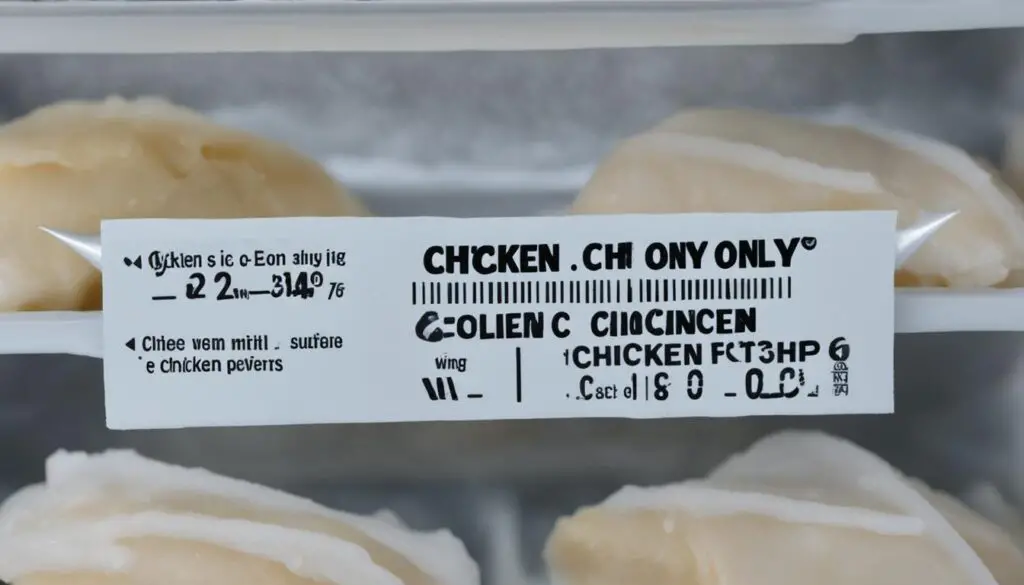When it comes to frozen chicken, you may be wondering if it can go bad. Well, the answer is yes, it can. There are several factors that can contribute to the spoilage of frozen chicken, such as being frozen past its expiration date or experiencing freezer burn.
Before freezing chicken, it’s important to check its quality. Take a look at its color and smell. If the chicken appears discolored or has an off smell, it may not be suitable for freezing.
When it comes to freezer burn, it can still be safe to eat, but it’s best to thaw and inspect the chicken for any off-color patches or funky smells before consuming.
In the next sections, we will explore how to determine if frozen chicken is bad, the proper storage and shelf life of frozen chicken, safe thawing methods, and using your senses to assess chicken freshness. By following these tips, you can ensure that the frozen chicken you consume is safe and of high quality.
How to Determine if Frozen Chicken is Bad
To determine if frozen chicken is bad, you can look for signs such as discoloration, greenish or gray patches, and a sour or rotten egg smell. Thawing the chicken and inspecting its color and odor is the best way to assess its quality. It’s important to note the best before date on the packaging and consume the chicken before that date for optimal freshness. Freezer burn, which can occur when the chicken is improperly sealed or stored for too long, does not necessarily make the chicken bad, but it may affect the taste and texture.

In order to determine if frozen chicken is still safe to eat, there are a few key indicators to look out for. One of the most obvious signs of spoiled frozen chicken is discoloration. If the chicken appears to have changed color, with greenish or gray patches present, it is a strong indication that the chicken has gone bad.
Another important factor to consider is the smell of the frozen chicken. If you detect a sour or rotten egg smell coming from the chicken, it is likely no longer safe to consume.
Thawing the frozen chicken is essential for a thorough inspection. Once thawed, inspect the color and texture of the chicken. If there are any notable changes, such as a slimy or sticky texture, it is best to discard the chicken.
When evaluating the quality of frozen chicken, always take into account the best before date indicated on the packaging. Consuming the chicken before this date ensures optimal freshness and reduces the risk of consuming spoiled chicken.
It’s important to note that freezer burn, which can occur when the chicken is improperly sealed or stored for too long, does not make the chicken bad in terms of safety. However, it may result in changes to the taste and texture of the chicken, making it less enjoyable to eat.
Proper Storage and Shelf Life of Frozen Chicken
Properly storing frozen chicken is crucial for maintaining its quality and maximizing its shelf life. Here are some essential tips for storing frozen chicken:
1. Freezing Chicken Before the Best-Before Date
To ensure the longest possible shelf life, it’s important to freeze chicken before its best-before date. This ensures that the chicken retains its freshness and quality while in the freezer.
2. Using Freezer-Safe Packaging
When storing frozen chicken, always use freezer-safe packaging to prevent freezer burn and maintain the chicken’s texture and taste. Vacuum-sealed bags, heavy-duty freezer bags, or airtight containers are ideal options for packaging frozen chicken.
3. Removing Excess Air
Excess air in the packaging can lead to freezer burn, which can affect the quality of the frozen chicken. Before sealing the packaging, try to remove as much air as possible. This can be done by squeezing out the air from the bags or using a vacuum sealer.
4. Organizing the Freezer
Proper organization in the freezer can help maintain the quality of the frozen chicken. Keep the chicken away from other strong-smelling foods to prevent any flavors from transferring. Additionally, ensure that the freezer temperature is set at 0°F (-18°C) or below to preserve the chicken’s freshness.
By following these tips, you can extend the shelf life of frozen chicken and ensure that it remains safe and delicious for future use.

| Type of Chicken | Shelf Life in the Freezer |
|---|---|
| Whole Raw Chicken | Up to 1 year |
| Chicken Pieces | Up to 9 months |
| Cooked Chicken | Up to 4 months |
Thawing Frozen Chicken Safely
When it comes to thawing frozen chicken, it’s crucial to prioritize safety to prevent any potential health risks. There are three common methods for thawing frozen chicken: the refrigerator method, the cold water method, and the microwave method. Each method has its own advantages and considerations, allowing you to choose the one that suits your needs and timeline.
The Refrigerator Method
The refrigerator method is the safest and most recommended way to thaw frozen chicken. This method requires minimal effort and helps maintain the quality and texture of the chicken. However, it does require some advanced planning, as it may take up to 24 hours or more depending on the size and thickness of the chicken pieces.
To thaw frozen chicken using the refrigerator method, follow these simple steps:
- Place the frozen chicken in a leak-proof bag or airtight container to prevent cross-contamination.
- Put the chicken on a plate or in a shallow pan to catch any potential drips.
- Store the chicken in the refrigerator, making sure it’s placed on the bottom shelf to avoid any juices from dripping onto other foods.
- Allow the chicken to thaw completely. This may take 24 hours or longer depending on the size and thickness of the chicken.
Once the frozen chicken is completely thawed, it’s essential to cook it immediately to ensure safety.
The Cold Water Method
The cold water method is a quicker alternative for thawing frozen chicken, but it requires more attention and monitoring compared to the refrigerator method. This method is suitable for times when you need to thaw chicken quickly and don’t have enough time for the refrigerator method.
To thaw frozen chicken using the cold water method, follow these steps:
- Place the frozen chicken in a leak-proof bag, ensuring there are no holes or openings.
- Fill a large bowl or sink with cold water.
- Submerge the chicken in the cold water, making sure it’s completely covered.
- Change the water every 30 minutes to ensure it stays cold.
- Continue the process until the chicken is thawed completely. This method usually takes about 1 to 3 hours, depending on the size and thickness of the chicken.
Just like with the refrigerator method, once the chicken is fully thawed, it’s crucial to cook it immediately for optimal safety.
The Microwave Method
The microwave method should only be used as a last resort when you need to thaw frozen chicken quickly. While it’s the fastest method, it’s important to note that uneven thawing may occur, which can lead to the growth of bacteria in some spots.
To thaw frozen chicken in the microwave, follow these guidelines:
- Remove any packaging or wrapping from the frozen chicken.
- Place the chicken on a microwave-safe dish.
- Set the microwave to the defrost setting or low power.
- Thaw the chicken in short bursts, typically for 2 to 3 minutes at a time, checking and rotating the chicken in between each burst.
- Once the chicken is partially thawed, remove it from the microwave and continue thawing using other methods before cooking immediately.
Remember, the microwave method should be used as a last resort due to the potential risks associated with uneven thawing. It’s crucial to cook the chicken immediately after thawing to ensure it’s safe to eat.
Thawing frozen chicken safely is essential to prevent any potential foodborne illnesses. By following these methods and prioritizing food safety, you can enjoy delicious and healthy chicken meals without compromising your well-being.
Thawing frozen chicken safely is crucial to prevent any potential foodborne illnesses. By following the refrigerator, cold water, or microwave methods, you can ensure that your chicken is ready for cooking. Always cook the thawed chicken immediately after thawing to maintain its safety and quality. Prioritizing proper thawing methods is key to enjoying delicious and healthy meals.
Using Your Senses to Determine if Chicken is Bad
When it comes to assessing the freshness of chicken, relying on your senses is key. By observing the color and smell of both raw and cooked chicken, you can quickly identify signs of spoilage. Here’s what to look out for:
Raw Chicken:
One of the first indicators of spoiled raw chicken is a change in color. Inspect the chicken, paying attention to any gray patches or yellow spots on the fatty areas. These discolorations may suggest that the chicken is no longer safe to consume. Additionally, trust your sense of smell; if you detect any sour or offensive odors emanating from the raw chicken, it’s best to err on the side of caution and discard it.
Cooked Chicken:
Even when cooked, chicken can still show signs of spoilage. Keep an eye out for any changes in color, particularly if the chicken turns gray or green-gray. This discoloration may indicate that the cooked chicken is past its prime. Equally important is the smell test – if you detect any new or unpleasant odors, it’s advisable to avoid consuming the chicken.

Remember, your senses can provide valuable insights into the freshness of chicken. By paying attention to color changes and trusting your nose, you can ensure that you’re consuming safe and enjoyable poultry.
Conclusion
In conclusion, it is important to be aware that frozen chicken can go bad if not properly stored or if it exceeds its expiration date. Signs of spoiled frozen chicken include discoloration and off smells.
To ensure the quality of frozen chicken, follow these tips:
- Freeze chicken before its best before date
- Store frozen chicken in freezer-safe packaging and remove excess air
- Thaw frozen chicken safely using recommended methods like the refrigerator method
- Use your senses to determine if raw or cooked chicken is still safe to eat
Remember, prioritizing food safety is essential when it comes to consuming frozen chicken. By following these guidelines, you can enjoy delicious and safe frozen chicken for your meals.
